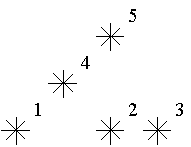传送门:Stars
Stars
| Time Limit: 1000MS | Memory Limit: 65536K | |
| Total Submissions: 29248 | Accepted: 12790 |
Description
Astronomers often examine star maps where stars are represented by points on a plane and each star has Cartesian coordinates. Let the level of a star be an amount of the stars that are not higher and not to the right of the given star. Astronomers want to know the distribution of the levels of the stars.

For example, look at the map shown on the figure above. Level of the star number 5 is equal to 3 (it's formed by three stars with a numbers 1, 2 and 4). And the levels of the stars numbered by 2 and 4 are 1. At this map there are only one star of the level 0, two stars of the level 1, one star of the level 2, and one star of the level 3.
You are to write a program that will count the amounts of the stars of each level on a given map.

For example, look at the map shown on the figure above. Level of the star number 5 is equal to 3 (it's formed by three stars with a numbers 1, 2 and 4). And the levels of the stars numbered by 2 and 4 are 1. At this map there are only one star of the level 0, two stars of the level 1, one star of the level 2, and one star of the level 3.
You are to write a program that will count the amounts of the stars of each level on a given map.
Input
The first line of the input file contains a number of stars N (1<=N<=15000). The following N lines describe coordinates of stars (two integers X and Y per line separated by a space, 0<=X,Y<=32000). There can be only one star at one point of the plane. Stars are listed in ascending order of Y coordinate. Stars with equal Y coordinates are listed in ascending order of X coordinate.
Output
The output should contain N lines, one number per line. The first line contains amount of stars of the level 0, the second does amount of stars of the level 1 and so on, the last line contains amount of stars of the level N-1.
Sample Input
5 1 1 5 1 7 1 3 3 5 5
Sample Output
1 2 1 1 0
Hint
This problem has huge input data,use scanf() instead of cin to read data to avoid time limit exceed.
Source
解题报告:
算法有很多种,最实用的是树状数组
由于本题的数据输入是以y坐标的升序输入,所以,只需要比较x坐标即可
树状数组存储的是某一段范围内有多少个点,即求和.
代码如下:
#include<iostream>
#include<cstdio>
#include<cstring>
#define N 15005
#define M 32005
using namespace std;
int ans[M],x[N],result[M];
int n,y,maxn;
int lowbit(int n){ //lowbit
return n & (-n);
}
void modify(int x){ //修改modify
for(int i = x; i<=maxn+1; i+=lowbit(i))
ans[i]++;
}
int getSum(int x){ //求和sum
int sum= 0;
for (int i = x; i > 0; i -= lowbit(i))
sum += ans[i];
return sum;
}
int main(){
int i;
scanf("%d", &n);
maxn = 0;
for(i=1; i<=n; i++){
scanf("%d%d", &x[i], &y);
maxn = max(x[i],maxn);
}
memset(result, 0, sizeof(result));
for(i=1; i<=n; i++){
result[getSum(x[i]+1)]++;
modify(x[i]+1);
}
for(i=0; i<n; i++)
printf("%d\n", result[i]);
return 0;
}






 本文介绍了一种利用树状数组高效解决天文星图中星等分布计数问题的方法,通过输入星图坐标,输出每个星等级的数量。
本文介绍了一种利用树状数组高效解决天文星图中星等分布计数问题的方法,通过输入星图坐标,输出每个星等级的数量。
















 693
693

 被折叠的 条评论
为什么被折叠?
被折叠的 条评论
为什么被折叠?








